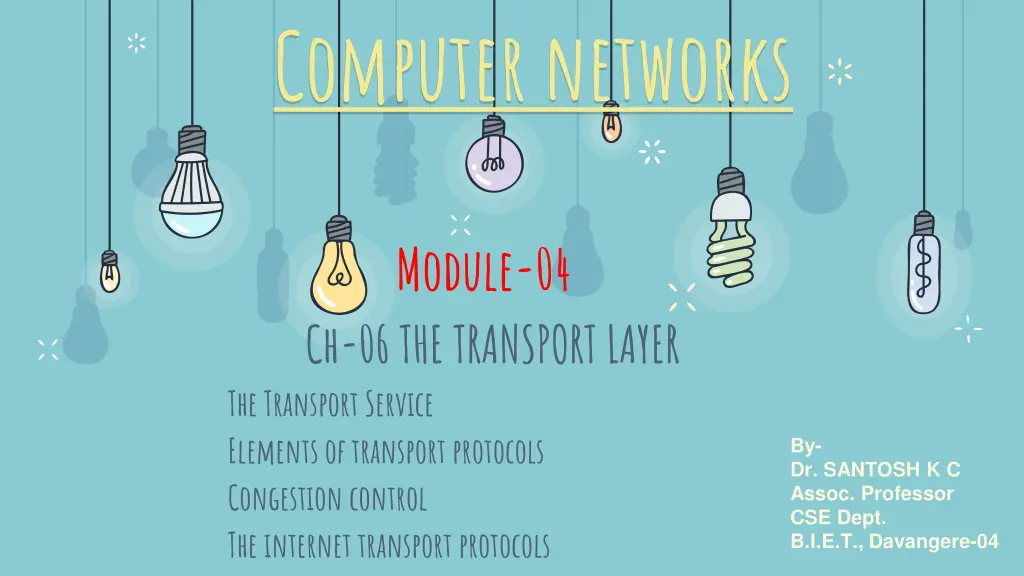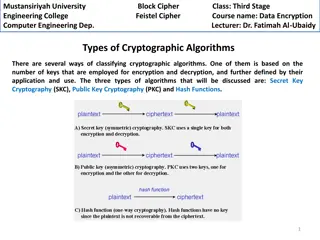
Understanding Transport Layer Protocols
Explore the world of transport layer protocols in computer networks. Learn about the services they provide, congestion control, elements of transport protocols, connection establishment, error control, flow control, and more. Dive into the communication between application processes on different hosts and the logical communication they facilitate.
Download Presentation

Please find below an Image/Link to download the presentation.
The content on the website is provided AS IS for your information and personal use only. It may not be sold, licensed, or shared on other websites without obtaining consent from the author. If you encounter any issues during the download, it is possible that the publisher has removed the file from their server.
You are allowed to download the files provided on this website for personal or commercial use, subject to the condition that they are used lawfully. All files are the property of their respective owners.
The content on the website is provided AS IS for your information and personal use only. It may not be sold, licensed, or shared on other websites without obtaining consent from the author.
E N D
Presentation Transcript
Computer networks Module-04 Ch-06 THE TRANSPORT LAYER The Transport Service Elements of transport protocols Congestion control The internet transport protocols By- Dr. SANTOSH K C Assoc. Professor CSE Dept. B.I.E.T., Davangere-04
Introduction and Transport-Layer Services A transport-layer communication between application processes running on different hosts. protocol provides for logical As shown in Figure 3.1, transport-layer protocols are implemented in the end systems but not in network routers. On the sending side, the transport layer converts the application-layer messages it receives from a sending application process into transport-layer packets, known as transport-layer segments. Note that network routers act only on the network-layer 3
A Transport-layer protocol provides logical communication between processes running on different hosts, a Network-layer protocol provides logical communication between hosts. Household Analogy: 12 kids in Ann s house sending letters to 12 kids in Bill s house: Hosts = Houses Processes = Kids/cousins Application messages = Letters in envelopes Transport-layer protocol = Ann and Bill who mux/demux to in-house siblings Network-layer protocol = Postal service 5
6.2 ELEMENTS OF TRANSPORT PROTOCOLS Connection Establishment Three-way handshake 9
ErrorControlandFlowControl CRC or checksum ARQ (Automatic Repeat reQuest). Stop-and-wait Sliding window 12
Multiplexing 13
6.3 CONGESTION CONTROL Regulating the Sending Rate Regulating the Sending Rate 14
THE INTERNET TRANSPORT PROTOCOLS: TCP UDP UDP is is a a simple such such as as client most most Internet needed needed. . simple protocol protocol and client- - server server interactions Internet applications, applications, reliable, and it it has interactions and reliable, sequenced has some some very and multimedia, multimedia, but sequenced delivery very important important uses, uses, but for delivery is is for UDP UDP cannot called called TCP cannot provide TCP and and is is the provide this, the main this, so main workhorse workhorse of of the so another another protocol protocol is is required the Internet Internet. .. . required. . It It is is 16
The TCP Service Model TCP service is obtained by both the sender and the receiver creating end points, called sockets sockets. . Each socket has a socket number (address) consisting of the IP address of the host and a 16-bit number local to that host, called a port port. . 17
Port numbers below 1024 are reserved for standard services that can usually only be started by privileged users (e.g., root in UNIX systems). They are called well well- -known known ports The list of well-known ports is given at www.iana.org. Over 700 have been assigned. A few of the better-known ones are listed inFig.6-34. ports. . 18
TCP Connection Establishment Connections are established in TCP by means of the three way hand shake discussed in Sec.6.2.2. To establish a connection, one side, say, the server, passively waits for an incoming connection by executing the LISTEN LISTEN and ACCEPT ACCEPT primitives in that order. The other side, say, the client ,executes a CONNECT specifying the IP address and port to which it wants to connect. CONNECT primitive, 20
End of Transportation Layer 23

